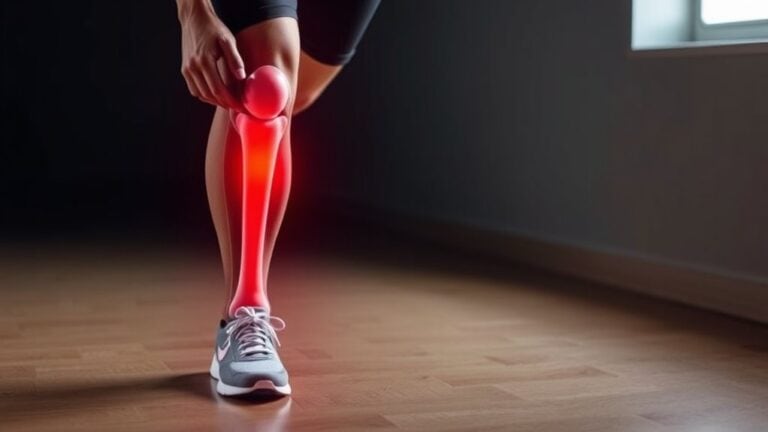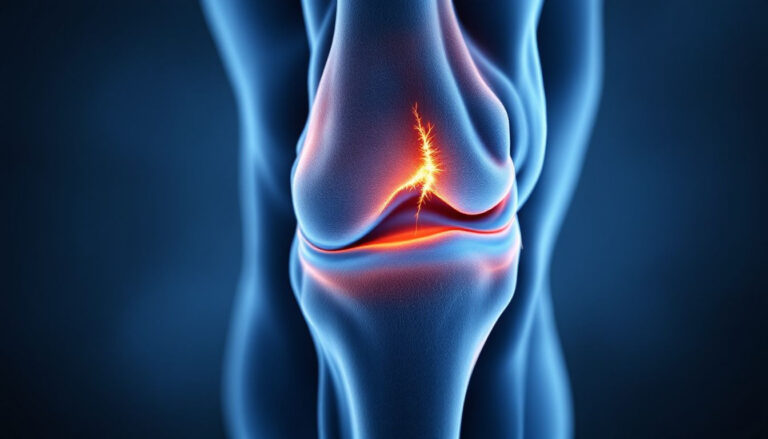Knee fluid drainage, or aspiration, is a common procedure as swelling causes discomfort or limits movement. The amount removed depends on the issue—whether it’s an injury, infection, or chronic condition like arthritis. Smaller amounts (10-50 mL) suggest mild inflammation, while larger volumes (over 100 mL) often point to serious problems like infections or severe joint damage. Comprehension of what’s normal—and what’s not—can help ease worries about the process. So, what exactly determines how much fluid comes out?
Understanding Knee Aspiration and Fluid Drainage
A knee aspiration procedure removes excess fluid that builds up in the joint, often due to injury, infection, or inflammation. The knee joint can swell when too much fluid accumulates, causing pain and stiffness.
During aspiration, a needle is inserted to drain the fluid, typically removing 10 to 50 milliliters, though severe swelling can require draining up to 100 milliliters or more. The amount depends on the patient’s discomfort and the joint’s tension.
The drained fluid is then analyzed to identify the cause, whether it’s arthritis, infection, or trauma. Removing the fluid eases pain, restores mobility, and helps guide treatment. Whilst the procedure sounds intense, it’s often quick and provides significant relief for those struggling with persistent knee swelling.
Common Conditions Leading to Knee Effusion
Knee effusion, the buildup of excess fluid in the joint, often stems from specific conditions that irritate or damage the joint lining. Osteoarthritis causes chronic inflammation, leading to pain and fluid accumulation in the knee joint.
Acute injuries, like sprains or meniscal tears, trigger sudden swelling as joint fluid mixes with blood. Infections, such as septic arthritis, fill the knee with cloudy, pus-filled fluid, accompanied by severe pain. Inflammatory diseases like rheumatoid arthritis thicken the synovial fluid, making the knee stiff and swollen.
Baker’s cysts, though not directly in the joint, can leak fluid, mimicking knee effusion. Each condition varies in how much fluid accumulates, but all share discomfort and limited mobility. Recognizing these causes helps in seeking timely care.
Typical Volume of Fluid Removed During Aspiration
During a knee aspiration procedure, doctors typically remove between 10 and 50 milliliters of fluid, though severe swelling can require draining up to 100 milliliters. The amount of fluid on the knee varies depending on the condition causing the buildup, but joint aspiration aims to relieve pressure and collect Synovial fluid for analysis.
Medical professionals carefully monitor the process to avoid discomfort or complications.
- Normal Range: Most cases involve 10–50 mL, with larger volumes indicating significant inflammation or injury.
- Diagnostic Use: The extracted fluid helps identify infections, gout, or arthritis, guiding treatment.
- Patient Comfort: Draining occurs gradually to prevent sudden shifts in joint pressure, reducing pain.
Understanding the typical volume removed during this procedure reassures patients about its safety and purpose. The process balances relief with diagnostic needs, ensuring effective care.
Factors Influencing the Amount of Fluid Drained
The amount of fluid drained from the knee often depends on how severe the joint condition is, with more severe inflammation typically producing larger volumes.
The purpose of the procedure also plays a role, as diagnostic aspirations could extract just enough fluid for testing, while therapeutic ones aim to relieve pressure by draining as much as feasible.
Comprehending these factors helps establish realistic expectations for the volume removed.
Joint Condition Severity
Several factors determine how much fluid gets drained from a swollen knee, with the fundamental joint condition playing a core role. The volume of fluid drained during a knee aspiration often reflects the severity of the joint effusion, ranging from a few milliliters to over 100 milliliters.
Acute injury or trauma: Typically yields 20–50 milliliters of fluid, as sudden knee swelling from impacts or strains creates moderate joint effusion.
Chronic inflammation (e.g., rheumatoid arthritis): Often produces 50–100 milliliters due to persistent irritation. Severe flares or long-term conditions lead to larger fluid buildup.
Infection (septic arthritis): Can exceed 100 milliliters, as bacterial infections aggressively inflame the joint, causing rapid fluid accumulation.
The amount of fluid drained helps diagnose the core issue, guiding treatment for relief and recovery.
Procedure Purpose Type
While knee fluid buildup varies, the reason behind the swelling plays a big part in how much gets drained. The procedure, called aspiration, removes excess fluid to reduce knee pain and diagnose causes.
Around 20-50 ml is often taken for acute injuries, while inflammatory conditions like gout could need 30-80 ml. Infections require more—sometimes over 100 ml—to clear harmful fluid. A local anesthetic is used to numb the area, making the process more comfortable.
The amount drained depends on comfort, joint safety, and lab testing needs. Some fluid might stay for analysis, even if swelling remains. Doctors balance relief with caution, ensuring enough is removed without over-draining. Each case is unique, so volumes differ.
The Knee Aspiration Procedure Explained
The knee aspiration procedure involves carefully inserting a needle to remove excess fluid, a process guided by proper technique to minimize discomfort.
After the fluid is extracted, it’s analyzed in a lab to pinpoint the cause of swelling, such as injury or infection.
Following the procedure, patients receive care instructions to reduce swelling and prevent complications.
Procedure Overview
Knee aspiration, a straightforward procedure, involves removing excess fluid from the joint to relieve discomfort or diagnose an issue. The process targets the soft tissue around the knee, using a sterile needle to withdraw fluid, often referred to as “water on the knee.”
Purpose: Aspiration can ease pressure from excess fluid or collect samples for lab analysis.
Volume: Typically, 5–50 milliliters is drained, depending on swelling severity and diagnostic needs.
Preparation: The area is cleaned, and sometimes a joint injection of numbing medication is given for comfort.
The amount removed varies—larger volumes for relief, smaller for testing. The procedure is quick, with minimal downtime, and helps pinpoint causes like infection or arthritis.
Needle Insertion Technique
After discussing the basics of knee aspiration, including the typical volume of fluid removed, attention turns to how the procedure is performed. The aspiration is a procedure where a provider inserts a needle and syringe into the knee joint, often near the patella. Positioning matters—patients could sit or lie with the knee slightly bent for easier access.
Discomfort is common, causing some pain around the aspiration site, but the provider might give a numbing agent to ease this. Slow withdrawal of fluid helps to minimize discomfort, adjusting the needle if drainage stalls. Although uncommon, swelling or worsening pain after requires medical attention.
The goal is efficient fluid removal with minimal distress, guided by expertise and patient feedback.
Post-Aspiration Care Advice
Recovering from knee aspiration involves simple steps to keep discomfort low and prevent complications. The initial step to remember is to follow the medical care instructions provided by the healthcare provider, as they help address the root cause of fluid buildup. A knee brace may be suggested to stabilize the joint and reduce swelling.
- Rest the knee for at least 24–48 hours, avoiding strenuous activities to prevent reaccumulation of fluid.
- Apply ice intermittently to reduce pain and inflammation, but avoid direct skin contact to prevent frostbite.
- Monitor for signs of infection, such as increased redness, warmth, or fever, and report them immediately.
The provider will explain the procedure’s aftercare in detail, ensuring a smooth recovery. Keeping the knee elevated can also help minimize swelling.
What Happens After Fluid Is Drained
The procedure to remove excess fluid from the knee often brings quick relief, easing discomfort and restoring movement. A swollen knee can feel noticeably better once the pressure is reduced, allowing for easier bending and walking.
After aspiration, the fluid is analyzed to DIAGNOSE AND TREAT the fundamental cause, whether it involves knee ligaments, infection, or inflammation. Pain and swelling typically lessen, but medical advice usually includes resting the joint and applying ice to prevent further irritation.
While mobility improves, patients should avoid strenuous activity to let the knee heal. The process not only addresses immediate symptoms but also helps identify essential issues, ensuring proper care. Follow-up visits might be needed to monitor recovery and prevent recurrence.
Risks and Considerations of Knee Aspiration
While knee aspiration often provides speedy alleviation, it’s pivotal to comprehend the potential hazards and considerations before undergoing the procedure. Fluid drainage from the knee can vary, and excessive fluid removal may disrupt joint pressure, leading to discomfort or complications.
Joint Pressure Changes: Removing too much fluid (over 100-150ml) could cause a sudden drop in joint pressure, potentially leading to instability or nerve irritation.
Repeat Aspirations: Frequent fluid drainage increases infection risks and might weaken joint tissues over time.
Post-Procedure Care: Monitoring for swelling, redness, or pain is essential to catch infections promptly.
Though knee aspiration is generally safe, cognizance of these factors helps patients and doctors make informed decisions, balancing alleviation with long-term joint health. Proper care minimizes risks while addressing excessive fluid buildup effectively.
Conclusion
Knee fluid drainage varies based on the cause, but one striking statistic stands out: infections often require removing over 100 mL of fluid—enough to fill half a standard coffee cup. While most cases involve smaller amounts, this highlights how serious joint infections can be. Proper drainage not only eases discomfort but also helps doctors diagnose and treat the issue, ensuring the knee heals smoothly and safely.





